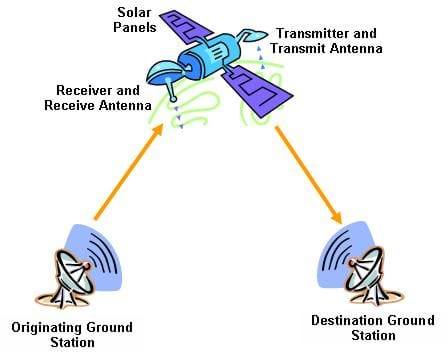Definition of Satellite:
It is an object that orbits about some body (i.e planet, dwarf planet, asteroid, or star of a larger size.) capable of exerting a gravitational force.
ADVANTAGES:
1) Used in long distance communications such as in television,fax,internet etc
2) Used in television and radio broadcasting etc
3) Weather forcasting (i.e) in prediction of rainfall, snowfall, storm etc
4) Agricultural monitoring (i.e) crop disease, crop failure.
5) Collecting information about other planets, stars and other celestial bodies
Generally, a satellite has been classified in following classes:
(i) Natural Satellites
A natural satellite is a celestial body that orbits a planet or other body larger than itself. The term is normally used to identify non-artificial satellites of planets, dwarf planets, or minor planets. Such objects are often called moons. There are upto 240 known moons within the solar system, including 163 orbiting the planets, four orbiting dwarf planets.
Earth's Moon is the most obvious example and was the only one known until the discovery of the Jupiter in 1610. All the solar system's planets except Mercury and Venus have moons, which vary greatly in size, composition (from rock to mostly ice), and activity (from cold and inert to volcanic). Some asteroids are also known to have their own moons.
The orbital properties and compositions of natural satellites provides us with important information on the origin and evolution of the satellite system. Especially a system of natural satellites orbiting around a gas giant can be regarded as a miniature solar system that contains precious clues for studying the formation of solar systems.
Irregular vs Regular Satellites
Natural satellites have been further divided in
two classes:
(a) Regular satellite is a natural satellite following a relatively close and generally prograde orbit with little orbital inclination or eccentricity. They are believed to have formed in orbit about their primary, as opposed to irregular moons, which were captured. The regular satellites are two of Mars, inner five of Jupiter, inner seven of Saturn etc.
(b) Irregular satellite is a natural satellite following a distant, inclined, and often eccentric and retrograde orbit. They are believed to have been captured by their parent planet, unlike regular satellites, which form in situ.
(ii) Artificial Satellites:
Artificial satellite is a man-made device placed in orbit around the earth, moon, or another planet used for communication and transmitting scientific information to earth.
The electrical power required by satellite is provided by panels of solar cells and small nuclear reactors. Satellites are kept in the correct position by small rocket motors called thrusters. They orbit with their disc aerials pointing to Earth. When the thrusters run out of fuel, the satellite eventually drifts out of position and becomes unusable. Satellites are equipped with radio transmitters, radio receivers and electronic circuits for storing data.
The first artificial satellite, Sputnik I, was launched by the USSR on October 4, 1957 into orbit around Earth. Since then, thousands have been sent into orbit around Earth as well as the Moon, Venus, Mars, Jupiter, and other bodies.

Artificial satellites have many uses, including relaying communication signals, making accurate surveys and inventories of the earth's surface and weather patterns, and carrying out scientific experiments.
 Functions and Types of Satellites:
Functions and Types of Satellites:
Satellites can be divided into six principal types based on their functions i.e.
(i) Research
(ii) Communications
(iii) Weather
(iv) Navigation
(v) Applications and
(vi) Military satellites
(I) Research satellites:
These measure fundamental properties of outer space, e.g., magnetic fields, the flux of cosmic rays and micrometeorites, and properties of celestial objects that are difficult or impossible to observe from the earth. Early research satellites included a series of orbiting observatories designed to study radiation from the sun, light and radio emissions from distant stars, and the earth's atmosphere. Notable research satellites have included the Hubble Space Telescope , the Compton Gamma-Ray Observatory, the Infrared Space Observatory, and the Solar and Heliospheric Observatory.
(ii) Communications satellites:
These provide a worldwide linkup of radio, telephone, and television. The first communications satellite was Echo 1, launched in 1960. Relay 1 and Telstar 1, both launched in 1962, were the first active communications satellites; Telstar 1 relayed the first live television broadcast across the Atlantic Ocean. In principle, these can provide complete coverage of the earth's surface, instantaneous communications throughout the world and a variety of telecommunications tasks.
(iii) Weather satellites or meteorological satellites:
These provide continuous, up-to-date information about large-scale atmospheric conditions such as cloud cover and temperature profiles. Tiros 1, the first such satellite, was launched in 1960; it transmitted infrared television pictures of the earth's cloud cover and was able to detect the development of hurricanes and to chart their paths. Current weather satellites can transmit visible or infrared photos, focus on a narrow or wide area, and maneuver in space to obtain maximum coverage.
(iv) Navigation satellites:
These were developed primarily to satisfy the need for a navigation system that nuclear submarines could use to update their inertial navigation system. This led the U.S. navy to establish the Transit program in 1958. Transit satellites provided a constant signal by which aircraft and ships could determine their positions with great accuracy. It provides greater accuracy in a shorter time; users can obtain information 24 hours a day. These satellites were of enormous help to transportation companies, especially transportation over water and through the air.Navigation satellites are also used for distance measurements for instance between buildings.
(v) Applications satellites:
These are designed to test ways of improving satellite technology itself. Areas of concern include structure, instrumentation, controls, power supplies, and telemetry for future communications, meteorological, and navigation satellites.
(vi) Military Satellites
Satellites also have been used for a number of military purposes, including infrared sensors that track missile launches; electronic sensors that eavesdrop on classified conversations; and optical and other sensors that aid military surveillance. These are Very similar to weather satellites but generally with higher resolution cameras and instead of normal communications equipment, they use encryption as well.